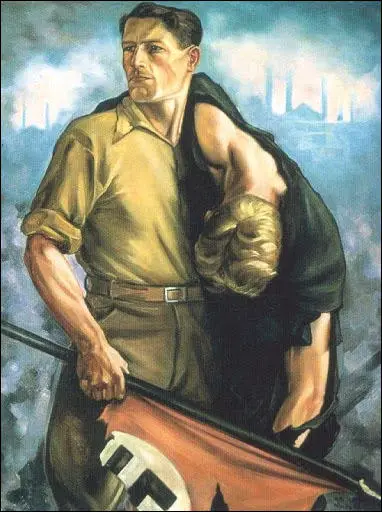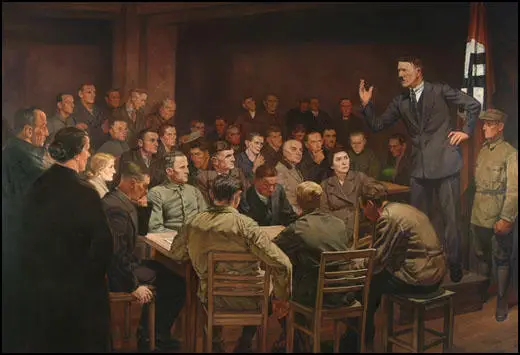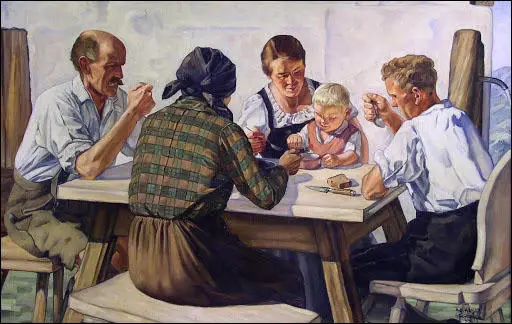Hermann Otto Hoyer
Hermann Otto Hoyer was born in Brema, Germany, on 25th January 1893. He studied and worked as a painter on glass in Metz. He joined the German Army on the outbreak of the First World War. (1) Hoyer was wounded at the Battle of the Marne and was taken prisoner. He escaped from prison camp in Marseille with a friend, who was killed by a bullet during the flight, while Hoyer reached Switzerland with his right arm badly injured and fractured. He learned with great difficulty working with the left hand and in 1919 attended the Art Academy in Monaco. (2)
Hoyer painted landscapes, nudes and portraits. An early member of the Nazi Party and a great supporter of Adolf Hitler and he painted several pro-fascist pictures including SA Man Rescuing Wounded Comrade in Street (1933). He also produced paintings depicting the rural population. This included In the Allgäu (c. 1935) (3)

It was decided to hold a Great German Art Exhibition in Munich. Hubert Wilm, a pro-Nazi artist, explained what they were trying to achieve: “Representation of the perfect beauty of a race steeled in battle and sport, inspired not by antiquity or classicism but by the pulsing life of our present-day events”. (4) Adolf Ziegler, signed the announcement for the competition. "All German artists in the Reich and abroad" were invited to participate. The only requirement for entering the competition was German nationality or "race". After extending the deadline for submissions, 15,000 works of art were sent in, and of these about 900 were exhibited. According to official records, the exhibition had 600,000 visitors. (5)
Hermann Otto Hoyer's, Hitler In the Beginning was the Word (1937) was also shown in the exhibition: "Here Hitler can be seen haranguing a small crowd seated in a dark room in Oberstdorf, Upper Bavaria, where the rookie politician, historically correct, proselytizes for the nascent NSDAP in the very early 1920s. In front of a swastika flag and flanked by an archetypal storm trooper, Hitler dressed in a simple suit and tie, gesticulates effectively, with onlookers captive - among them, the closest, a woman." (6)

Adolf Hitler bought Hitler In the Beginning was the Word for the planned art gallery in Linz. This painting was reproduced in thousands of postcards and art magazines. In much of the literature on the art of the Third Reich, the painting is presented as a model for the creation of the myth of the dictator seen as the messiah. (7)

Although he only had one arm he volunteered for the Waffen-SS with the rank of Obersturmführer (lieutenant). In 1943 he was appointed Professor dell 'Accademia. Many of the works were reproduced in postcards. At the end of the war he was arrested and detained until 1947. Most of his paintings were confiscated by the Allied forces. (8)
Hermann Otto Hoyer died on 30th May 1968.
Primary Sources
(1) Galleria Thule Italia, Herman Otto Hoyer (3rd June 2009)
Hermann Otto Hoyer was born 25 January 1893 a Brema. He studied and worked as a painter on glass in Metz, Nancy and Basilea. Before carrying out his military service in Bremen in 1913/14 trascorse un semestre presso Josef Goller alla Arts School di Dresda. In the First World War at the Battle of the Marne was wounded by a piece of shrapnel and was taken prisoner and locked up, as recounted later, "Rat in a cage in Britain". He had to remain in captivity for more than two years so that he could regain his freedom a friend, Judge, son of the owner of the brewery Oberstdorf a village in southern Germany nell'Oberallgäu. After two attempts to escape unfortunate was brought to the "concentration camp for refugees" of Graiba in Tunisia which provided 14 hours a day of work and only one round of cleaning staff each 60 days. On his third attempt to escape was captured just before the front of Tripoli and buried for 60 days in a cage by the shape of the tent without moving. The next stage of his military detention ordeal was Emzarir where raging typhus and malaria. The prison camp was then moved to Marseille. From there he escaped with a friend, who was killed by a bullet during the flight, while Hoyer reached Switzerland with his right arm badly injured and fractured. He learned with great difficulty working with the left hand and the 1919 to the 1925 attended the Art Academy in Monaco with Hermann Groeber favorite pupil of Franz von Stuck and Carl von Marr.
(2) The Holocaust Memorial Museum (June, 2020)
Painting by Hermann Otto Hoyer, entitled, "In the Beginning Was the Word," ca. 1937. German artist Hoyer depicted a quasi-messianic Hitler mesmerizing an audience with his oratory in the 1920s. The artwork’s title is from the opening line of the New Testament Gospel of John: "In the beginning was the Word, and the Word was with God, and the Word was God." This and 400 other Nazi-era artworks still considered politically charged remain in the U.S. Army’s custody today.
(3) Michael H. Kater, Culture in Nazi Germany (2019)
Two most imposing pictures of him are by Fritz Erler and Heinrich Knirr; they show the Führer in Party uniform, standing upright, with imperious gaze and resolute mien. Erler painted him in the classic SA uniform with cap in hand, before the mighty monument of a naked sword-bearer with a falcon in his open palm. Knirr's Hitler wears a topcoat against the background of a verdant forest the neo-Romanticists were won't to invoke; Hitler is adorned by a swastika armband and his World War I Iron Cross, and he looks most statesmanlike and less threatening. This portrait was mounted at the "Great German Art" exhibition of July 1937, one of twelve there of the Führer.
Another picture of that venue which Hitler had insisted be shown became a veritable cornerstone of Hitler's iconography, a painting entitled In the Beginning was the Word by Hermann Otto Hoyer. Here Hitler can be seen haranguing a small crowd seated in a dark room in Oberstdorf, Upper Bavaria, where the rookie politician, historically correct, proselytizes for the nascent NSDAP in the very early 1920s. In front of a swastika flag and flanked by an archetypal storm trooper, Hitler dressed in a simple suit and tie, gesticulates effectively, with onlookers captive - among them, the closest, a woman. Hoyer, whose likeness of himself Hitler later purchased, was barely trained at the Dresden Academy of Arts, wounded in World War I, and an early Old Fighter. He eventually had himself appointed professor by the Führer, dutifully joining the Waffen-SS during the war.
